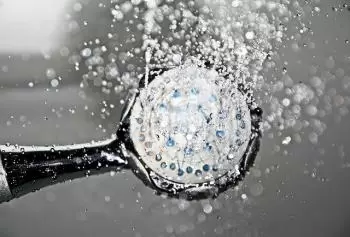
One of the main uses of solar thermal energy is the production of domestic hot water (DHW). Solar radiation is transformed into heat through solar collectors, raising the temperature of a fluid that is subsequently used in various hot water distribution systems.
This technology makes it possible to harness a renewable energy source to reduce the consumption of electricity or fossil fuels for water heating.
What is domestic hot water?
Domestic hot water (DHW) is water intended for human consumption that has been preheated. It is used in various areas, such as:
- Sanitary uses (baths, showers, etc.).
- Cleaning uses (washing dishes, clothes, etc.).
- Heating systems.
In terms of energy, DHW accounts for between 25% and 40% of household energy consumption. Its production through solar thermal energy eliminates the need for electric water heaters and offers an efficient alternative to heat pumps in heating systems.
Operation: obtaining hot water using solar energy
The simplest way to obtain hot water for domestic use is through solar energy.
Solar collectors capture solar radiation, which heats the water circulating through them. The fluid increases its internal energy and temperature. This fluid circulates through a heat exchanger, which transmits thermal energy to the water we want to heat.
Hot water can be transported, thus allowing energy to be transported. The heated water can be stored in a well-insulated tank or circulated through a heating circuit to heat a home.
The basic elements that make up a DHW installation are:
-
Water heater
-
Circulation pump
-
Pipes
-
Flowmeters
-
Valves for the distribution of hot water to consumption points.
Obtaining domestic hot water is one of the most widely used applications of solar thermal energy. It's a good option for single-family homes and also for residential communities.
Performance of a DHW installation
Solar efficiency is determined by the angle the sun's rays form with respect to the ground. In summer, the sun is more perpendicular to the ground than in winter, so we receive more solar radiation in summer.

The energy required to heat domestic hot water to a certain temperature depends on the initial temperature of the water before it passes through the circuit. Therefore, in winter, when the water coming from the mains is generally colder, more thermal energy will be required than in summer.
Solar hot water installations require a water tank so that the heated water is stored in a well-insulated tank for when it's ready to be used.
This is essentially due to two reasons:
-
Due to the difference in solar radiation received during the different hours of the day, not to mention the zero solar radiation received at night and,
-
Because we are not going to use hot water constantly, that is, most of the day we would not use water but when we wanted to shower we would use a lot of hot water in a very short time.
Sizing a DHW system
From an economic standpoint, a solar thermal energy installation cannot be designed to provide all the hot water we need year-round. In this case, we would have to consider a much larger installation to be able to obtain a large amount of heat energy in winter.
We would have excess energy in the summer, which would cause the water in the storage tank to boil, generating water vapor, and the pressure of this vapor would eventually burst the tank.
One solution would be to throw away hot water and add cold water, but that would be unreasonable in terms of both cost and environmental impact.
There are numerous regulations in different countries that govern the size of solar thermal energy systems for domestic hot water. The goal is to ensure they are built for reasonable consumption in the summer and have a backup system when the system cannot reach the desired water temperature.
Types of DHW system installations
There are two types of hot water installations (or heaters):
-
Open-circuit domestic hot water installations. Drinking water flows directly through the solar collectors. This system reduces costs and is more efficient. However, it presents problems in areas with very low temperatures or high salt concentrations.
-
Closed-circuit domestic hot water installations. Two systems are distinguished: thermosiphon flow and forced flow.
-
Instantaneous systems. These systems heat water when needed.
-
Storage systems. This is the most common system; hot water is stored in thermal storage tanks for supply when needed.